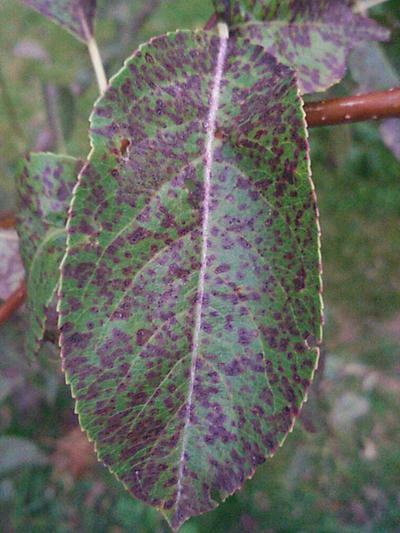Marssonina Blotch of Apple
Diplocarpon mali
Fungus
In a Nutshell
- Infects leaves, rarely fruits.
- Small leaf spots.
- Premature defoliation.
Can also be found in
Symptoms
Late in the summer dark spots (5-10 mm) begin to appear on the upper surface of mature leaves. The symptoms are visible invariably after the rains in spring and in the early summer months. The leaves of older apple plants are more susceptible to the blotch than younger ones. The spots are usually grayish, brown with a tinge of purple at the tips. The disease symptoms appear in form of dark green circular patches on upper surface of leaf giving rise to 5-10 mm brown leaf spots which become dark brown in due course. At maturity, it also develops on lower surface of the leaves. The fungus also attacks the fruit by causing circular dark brown spots of varying sizes (3-5 mm in diameter) on commercial cultivars. Small asexual fruiting bodies are often visible on the surface. When more lesions are forming, they coalesce, while the surrounding parts turn yellow. Severe infestation like this result in defoliation. The fungus can also infect fruit, though not very common.
Recommendations

Organic Control
Apply 10-12 sprays per year of each product of acid-clay Myco-Sin, or Funguran (copper hydroxide), Curatio (lime sulfur), or sulfur. Also, applying urea to overwintering leaves should reduce the primary innoculum level.

Chemical Control
Always consider an integrated approach with preventive measures together with biological treatments if available. It is more useful to use fungicides in a preventive way than curative manner. Use fungicides with active ingredients such as mancozeb, dodine and trifloxystrobin, which provide a significant reduction in the disease incidence. Copper-oxychloride can be applied after the harvest. Use Fungicides in combinations of dodine + hexaconazole, zineb + hexaconazole, mancozeb + pyraclostrobin for effective control and decrease in the possibilities of pest resistance. Protective sprays of Mancozeb (0.3%), copper oxychloride (0.3%), Zineb (0.3%), and HM 34.25SL (0.25%), Dodine (0.075%) and Dithianon (0.05%) provided complete disease control in the field.
What caused it?
The disease is caused by the fungi of Diplocarpon mali. It takes about 40 days for the fungi to exhibit obvious visible symptoms. Primary infections are usually initiated by ascospores which are produced on overwintered leaves. Rain is usually required for spore release. For infection, favorable conditions include 23.5°C and 20 mm of rain. A daily temperature of 25°C and 20 mm of rainfall are required for its development. The disease is favored by high rainfall and moderate temperature ranging from 20-22°C during the fruit development stages of Apple.
Preventive Measures
- None of the apple cultivars are resistant to marssonina blotch, however, Granny Smith and Gibson's Golden are moderately resistant.
- Do not cultivate Royal Delicious, Golden Delicious and Scarlet Spur as they are highly susceptible.
- Destroy spores of Diplocarpon mali by destroying fallen leaves in autumn.
- Practice proper sanitation of burning and burying of defoliated leaves.
- The incidence of the disease can be controlled through orchard sanitation, and pruning.



